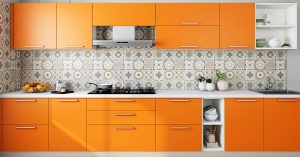Viktor Pravdica/Adobe Stock
Whether you are preparing to sell your home or you just want a refresh for a new season, a home project is a big undertaking. One of the biggest questions you may ask as you plan any home remodeling project is how to pay for it. This is especially true now that inflation is at one of its highest points in decades, making everything more expensive.
A recent Bankrate survey found that 53 percent of Americans are delaying important financial milestones due to the current economic climate, with 25 percent refraining from undertaking home improvements projects.
Thinking ahead about how to finance your home project is essential to avoid added costs and future financial problems. Saving up for a specific project and using those funds is the ideal way to pay for a home upgrade. However, that isn’t always possible and you may need to apply for financing instead.
If you’re in good financial health and the project will boost your home’s value, the extra cost of financing could be worth it. That said, you should be aware of roughly how much a planned project will cost before deciding to take the plunge.
Average cost of a home improvement
The average homeowner in the U.S. spends $18,000 in home renovations. However, this figure can fluctuate greatly based on the size of your home, type of project you choose, timing and location.
Home improvement statistics
- More than half of homeowners plan on postponing home renovation projects until 2024 due to supply shortages and high costs.
- Inflation has driven 71% of homeowners to do home improvement projects on their own rather than hiring a professional to save money.
- Over 60% of homeowners plan on using their checking or savings account to pay for home improvement projects in 2023.
- Credit cards, home equity loans and personal loans are also popular options to pay for home remodeling, accounting for 37.4%, 8.6% and 8.5% of all financing options, respectively.
- Improving a living space, fixing something that’s broken and increasing safety are the three top reasons homeowners are choosing to renovate their homes in 2023.
- The average household spent $18,000 in home renovations in 2021 — a 20% increase from the previous year.
- More than one-third of homeowners reported going over budget when it came to their home renovation projects in 2021. Meanwhile, 27% of homeowners said they didn’t have an initial budget.
- Interior room remodels, home system upgrades and outdoor upgrades accounted for 70%, 63% and 54% of all home renovation projects done by homeowners in 2021, respectively.
- Kitchen remodels are the most popular and expensive home renovation with a median spend of $15,000 per project.
- Bathroom remodels are the second most expensive home renovation project, with a median spend of $9,000.
7 best ways to finance home improvements
Home improvement projects can be expensive and often require financing. Luckily, several options are available to help you find the best option for your situation.
1. Save
The safest financial option to pay for your home renovation is to save a chunk of money for your project. If you don’t already have a large sum of money saved, this option can mean waiting longer to start your project. But, it also means you won’t have to worry about paying back a loan or large credit card bill once you finish your home renovation.
The amount you need to save depends on what type of renovation you’re doing and the scope of the project. If you’re looking to finance the whole project by saving, it might be smart to start small and take on less expensive projects first. This will ensure that you don’t get in over your head and wind up spending more than you intended.
| Benefits | Drawbacks |
|---|---|
| No money to have to pay back | Saving can take more time or delay the start |
| No accruing interest | The project may cost more than expected |
| Your credit score will not be impacted | You may not have time to save if the repair is an emergency |
2. Home improvement loans
Home improvement loans are unsecured personal loans offered by banks, credit unions and a number of online lenders. Because the loans are unsecured, you don’t need to use your house as collateral to qualify. Your interest rate and qualification are based largely on your credit score. Funding comes quickly; once you agree to the terms, many lenders deposit money straight into your account in as little as a day.
Home improvement loans typically have shorter repayment timelines, lower loan amounts and fewer fees than home equity loans or HELOCs. Most home improvement loans only go up to 12 years maximum. Home improvement loans also have much lower loan amounts, typically up to $100,000 at most, while home equity loans range up to $750,000. Home improvement loans are typically best for small or midsize projects in your home, such as a bathroom or kitchen makeover.
As unsecured loans, home improvement loans typically have higher rates, especially if you have fair or poor credit. Some lenders also charge fees for application processing, late payments and even prepayments on a remodel loan. However, you are not at risk of losing your home if you can’t pay.
Before applying for a personal loan for home improvement, compare the best home improvement loan lenders for low interest rates, competitive fees, friendly repayment terms and quick payouts.
| Benefits | Drawbacks |
|---|---|
| Funding is generally fast (within a few days) | Lower maximum borrowing amounts. |
| Many lenders charge no or few fees for home improvement loans. | Shorter repayment periods than a home equity loan |
3. Home equity line of credit (HELOC)
Because a HELOC is a secured loan — backed by your home — you can qualify for lower interest rates than you would for an unsecured personal loan. A HELOC is also revolving credit, which means you can take what you need when you need it (up to your borrowing limit). Because of this flexibility, HELOCs are well-suited for longer, bigger projects.
Because you’ll have to put your home up as collateral, it could be foreclosed if you don’t make payments on time. Most HELOCs also have variable interest rates, which means your payments can increase depending on market conditions.
To borrow against your house, you must have sufficient home equity. Make sure you have at least 15 percent to 20 percent equity in your home. The amount you’ll be eligible to borrow depends on your loan-to-value ratio, or LTV. This score consists of your home’s value, the outstanding value on your mortgage and your credit score. Before borrowing, calculate how much your monthly payments will be.
| Benefits | Drawbacks |
|---|---|
| Interest may be tax deductible. The Tax Cuts and Jobs Act allows home equity borrowers to deduct interest paid on home equity products if the product was used for home improvement | HELOCs come with variable interest rates, meaning that your interest rate can change depending on the decisions of the Federal Reserve. |
| HELOCs have flexible repayment options for up to 30 years depending on how much you borrow. | It can be easy to overspend with a line of credit. |
4. Home equity loan
Instead of a HELOC, you could apply for a home equity loan, which is sometimes referred to as a second mortgage. This is a loan paid out in a lump sum that you can repay over a number of years in regular fixed monthly payments.
Home equity loans have much higher borrowing limits and repayment periods than home improvement loans. Home equity loans are also secured, meaning you put your home up as collateral.
Unlike HELOCs, you don’t have to worry about market fluctuations with a home equity loan. Once you lock in your fixed interest rate, you pay the same monthly payment over the life of your loan.
Home equity loans are best suited for medium to large projects. You will need to know exactly how much you need before borrowing, but you can borrow more and have more time to pay back the debt.
| Benefits | Drawbacks |
|---|---|
| Fixed interest rates ensure your monthly payment will never change. | You must have a good credit score to qualify for the best rates. |
| Loan interest is tax deductible if you use the funds for home improvement. | If your property value declines, you could go upside down on your mortgage. |
5. Cash-out refinance
A cash-out refinance replaces your current mortgage with a new, larger loan and gives you a new interest rate. Because you get to pocket the difference between your old mortgage and the new loan, you could use the extra dollars from a cash-out refinance to make home improvements.
A cash-out refinance is a good option for homeowners who would not be able to afford an additional monthly loan payment without refinancing and who qualify for a better interest rate than they have with their existing mortgage. Because this financing method depends on the state of your current mortgage and comes with added costs, a cash-out refinance is best suited for smaller projects and emergency repairs.
If you’re thinking about refinancing, consider the drawbacks carefully. You’ll need to pay for an appraisal, origination fees, taxes and other closing-related costs. Unless you refinance your mortgage for a shorter term, you’ll be extending the life of your loan, meaning it will take you longer to pay it off. In general, refinancing is only a good idea if you can secure a lower interest rate than what you pay now. The average refinance closing cost in 2021 was $2,375 (without taxes).
| Benefits | Drawbacks |
|---|---|
| You can lower your monthly mortgage payment by refinancing | The amount you owe will increase with a cash-out refinance, putting you deeper in debt. |
| If you have an adjustable-rate mortgage, you can change it to a fixed-rate loan. | You need to have good to excellent credit to qualify for cash-out mortgage refinancing. |
6. Credit cards
If you’re making minor updates to your home, such as upgrading a bathroom vanity or installing a new closet system, using your credit card might be one of the best home improvement financing options.
Some cards are interest-free for the first few months. If you’re using a 0 percent introductory APR card, you could pay for minor home improvements without ever paying interest. Many cards also come with great rewards, so the more you spend on a renovation, the more cashback you could earn if your credit card offers cash-back perks.
There are some risks associated with making large home improvement purchases on a credit card. If you can’t pay your balance back before the introductory offer expires, you could face exceptionally high interest rates — much higher than other home remodel loan options. If you use your regular card instead of an introductory offer card, you’ll need to pay the entire amount back by your next billing cycle — usually a month — if you want to avoid interest. With variable interest rates, the amount you pay in interest could also rise as market conditions shift.
If you are planning to use a credit card for home improvement projects, it is worth looking into store-issued credit cards from places like IKEA or Lowes. These cards tend to have benefits for making purchases within those specific stores.
| Benefits | Drawbacks |
|---|---|
| Many cards offer rewards programs to borrowers that benefit you the more purchases you make on the card. | You will have to pay back what you borrow within the billing cycle to avoid paying high interest. |
| You can take out the amount you need as you need it, which can keep you from getting into more debt than necessary. | It is easy to overspend and get in a cycle of debt |
7. Government loans
If you qualify for a government loan, you could save on the costs of interest and insurance.
One type of government loan is a HUD Title I Property Improvement Loan. It lets you borrow up to $25,000 without having any equity in your home. This is a good home repair loan option if you’ve recently purchased your home and need to make upgrades. However, the money must go toward renovations that improve the livability of the home, and some upgrades may not qualify.
Examples of approved renovations include installing an appliance or making structural repairs. Your loan can also cover architectural and engineering costs, building permit fees, appraisal fees and inspection fees. These loans do not cover luxury items like swimming pools or outdoor fire pits. You also cannot use this loan to pay for work that has already been done.
Veterans Affairs also offers cash-out refinance loans, which allow you to refinance a conventional home loan and take out cash on the equity of your home. If you can’t make payments, the VA loan guarantee is the “insurance” it provides to your lender.
Government loans tend to have lower interest rates and better terms than regular loans because the government insures the lender against potential loss. Exact rates vary and depend on the lender.
| Benefits | Drawbacks |
|---|---|
| You are guaranteed to work with a legitimate lender | You must use the loan money for projects that increase the property’s “livability”, meaning that you cannot use the money for luxury items. |
| You do not necessarily have to be the homeowner to apply for these loans. The Title I loan allows long-term tenants to apply. | Each government-issued loan comes with its own eligibility requirements. For the Title I loan, you need a debt-to-income ratio of 45% or less. |
Financing for emergency home repairs
If you need to make emergency repairs to your home and need help covering the immediate costs, you can turn to any of the options mentioned above. In addition to those options, you can take out a homeowners insurance claim.
Homeowners insurance typically comes with a steep deductible of $1,000, on average, which can be a stretch for some. In fact, a recent Bankrate survey found that 57 percent of Americans say they wouldn’t be able to cover a $1,000 emergency expense out of pocket. Additionally, claims can take a while to process and not all emergency repairs are covered.
If you do not have time to wait for an insurance claim to go through, a loan could be your best option. Home improvement loans and credit cards may work best for smaller repairs, but larger repairs may require a home equity loan or HELOC.
Homeowners spent an average of $2,321 on emergency home repairs in 2021. The exact cost depends on the specific repair, as well as the cost and availability of materials and labor. Some examples of emergency repairs include termite damage, which costs between $600 and $3,000 on average to repair, and water damage, which costs over $3,300 on average to repair.
Financing for emergencies with bad credit
If you struggle with your credit and are dealing with a home repair emergency, you may be wondering how you’ll be able to access the funds you need. Luckily, some lenders offer loans specifically for those with less-than-stellar credit.
If you’re worried about taking on more debt, it may be a good idea to look into a debt consolidation loan. These loans allow you to combine multiple debts into one payment. This option simplifies your finances, and you have the opportunity to find a loan with lower interest and fixed payments. Debt consolidation loans are available even for people with bad credit.
Before choosing a lender, make sure to compare top debt consolidation loans for borrowers with bad credit.
The bottom line
Financing a home project takes planning. Homeowners should consider all the options and choose the financing path that is best for their project and financial situation. When looking into different loan options, talk to multiple lenders to get the best terms.
Read the full article here














